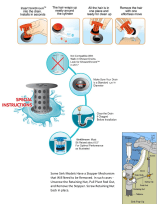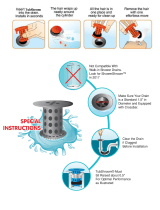
Operation
15
The
Safety System
Understanding the Safety System
The safety system is designed to prevent the engine
from starting unless:
• The clutch/brake pedal is depressed
• The blade control (PTO) is “DISENGAGED”
The safety system is designed to stop the engine if
you rise from the seat when the clutch/brake pedal is
released or the blade is “ENGAGED.”
Operating–in–Reverse
An interlock feature is provided that prevents the
Power Take Off (PTO) from operating while the
tractor is traveling in reverse. If the unit is shifted
into reverse while the mower blade or other PTO
driven attachment is engaged, the engine will stop.
Do not mow while backing up unless it is
absolutely necessary
. If you need to mow while in
reverse gear or use other PTO driven attachments
(such as a snowthrower or tiller), this
operating–in–reverse interlock feature may be
temporarily deactivated.
Before deactivating this feature, be sure there are no
children present on or near the property where you are
using the tractor, and that none are likely to appear
while you are mowing or operating an attachment.
Be extra observant after you have chosen to
deactivate the interlock feature because the sound of
the tractor’s engine might prevent you from being
aware that a child or a bystander has entered the area
where you are operating the tractor.
If you are certain that you can safely mow in reverse
or operate an attachment, deactivate the
operating–in–reverse interlock feature by turning the
“Key Choice” switch (Fig. 10), located in front of and
below the seat, after engaging the blade (PTO). A
red light on the front console (Fig. 11) will turn on as
a reminder that the operating–in–reverse interlock has
been deactivated. Once the interlock is deactivated it
stays in this mode––with your mower blade or
PTO–driven attachment operating whenever you back
up–– and the console light stays on until either the
blade (PTO) is disengaged, or the engine is turned
off.
Note: Do not insert the “Key Choice” key
unless it is absolutely necessary to
mow in reverse or operate an
attachment. The “Key Choice” key
should also be removed from the unit
if it will be operated by someone other
than a responsible, experienced
operator. This will prevent the unit
from operating in reverse with the
mower blade or other PTO attachment
engaged. Always remove both the
ignition and the “Key Choice” keys
and put them in a safe place out of the
reach of children when leaving the unit
unattended.
POTENTIAL HAZARD
• A child or bystander could be backed over
by a riding mower with its blade(s)
engaged.
WHAT CAN HAPPEN
• Blade contact will cause serious personal
injury or death.
HOW TO AV
OID THE HAZARD
• Do not mow in r
everse unless absolutely
necessary.
• Always look backward and down before
backing up.
• Use “Key Choice” switch only if you are
certain no children or other bystanders will
appear in the mowing area.
•
Always r
emove both the ignition and Key
Choice keys and put them in a safe place
out of the reach of children or unauthorized
users when leaving the unit unattended.






















